Primary Hydrogen Reports Anomalous Hydrogen Readings From Phase 2 Exploration at Hopkins and Blakelock Projects, Northern Ontario
Primary Hydrogen (OTCQB:HNATF) reported Phase 2 exploration results from Hopkins and Blakelock, Northern Ontario, on November 12, 2025. The program covered 9,127 hectares and identified multiple hydrogen soil‑gas anomalies.
Key findings include a Hopkins peak of 245 ppm H₂ with a concentric anomaly pattern and a transient ambient air spike of 190 ppm H₂, plus a Blakelock 800‑metre corridor averaging 52 ppm H₂ (peak 77 ppm) aligned with a Matachewan mafic dyke. REE soil sampling returned no anomalous concentrations so far; six Hopkins samples remain pending. Work was conducted with INRS and measured with portable detectors; follow‑up surveys and expanded grids are planned.
Primary Hydrogen (OTCQB:HNATF) ha riportato i risultati esplorativi di fase 2 da Hopkins e Blakelock, Northern Ontario, il 12 novembre 2025. Il programma ha coperto 9.127 ettari e ha identificato multiple anomalie di gas nel suolo legate all'idrogeno.
I principali risultati includono un picco di Hopkins di 245 ppm di H₂ con un modello di anomalia concentriche e un picco transitorio nell'aria ambiente di 190 ppm di H₂, oltre a un corridor di 800 metri a Blakelock con una media di 52 ppm di H₂ (picco 77 ppm) allineato con una dykes mafica di Matachewan. Le analisi del suolo delle LREE non hanno mostrato concentrazioni anomale finora; sei campioni di Hopkins sono ancora in attesa. Il lavoro è stato condotto con INRS e misurato con rilevatori portatili; sono previste indagini di follow-up e griglie ampliate.
Primary Hydrogen (OTCQB:HNATF) reportó resultados de exploración de Fase 2 desde Hopkins y Blakelock, Northern Ontario, el 12 de noviembre de 2025. El programa cubrió 9,127 hectáreas y identificó múltiples anomalías de gas del suelo de hidrógeno.
Los hallazgos clave incluyen un pico Hopkins de 245 ppm H₂ con un patrón de anomalía concéntrico y un pico de aire ambiente transitorio de 190 ppm H₂, además de un corridor de Blakelock de 800 metros promediando 52 ppm H₂ (pico de 77 ppm) alineado con una dija mafica de Matachewan. El muestreo de suelos de REE no ha mostrado concentraciones anómalas hasta ahora; seis muestras de Hopkins quedan pendientes. El trabajo se realizó con INRS y se midió con detectores portátiles; se esperan encuestas de seguimiento y mallas expandidas.
Primary Hydrogen (OTCQB:HNATF)은 2025년 11월 12일 노던 온타리오의 Hopkins와 Blakelock에서의 2상 탐사 결과를 발표했습니다. 이 프로그램은 9,127헥타르를 커버했고 수소 토양-가스 이상을 다수 확인했습니다.
주요 발견으로는 Hopkins 피크 245 ppm H₂의 동심원형 이상 패턴과 주변 대기 190 ppm H₂의 일시적 스파이크, 그리고 Blakelock 800m 구간 평균 52 ppm H₂ (피크 77 ppm)가 Matachewan 엘리퀘 다이크와 정렬되어 있습니다. REE 토양 샘플은 아직 이상 축농을 보이지 않았고, Hopkins 샘플 6개가 보류 중입니다. 연구는 INRS와 함께 수행되었고 휴대용 탐지기로 측정되었습니다; 후속 조사와 확장된 격자가 계획되어 있습니다.
Primary Hydrogen (OTCQB:HNATF) a publié les résultats d'exploration de la phase 2 à partir de Hopkins et Blakelock, dans le nord de l'Ontario, le 12 novembre 2025. Le programme a couvert 9 127 hectares et a identifié de multiples anomalies de gaz du sol liées à l'hydrogène.
Parmi les principaux résultats figure un pic Hopkins de 245 ppm H₂ avec un motif d'anomalie concentrique et un pic d'air ambiant transitoire de 190 ppm H₂, ainsi qu’un corridor Blakelock de 800 mètres en moyenne 52 ppm H₂ (pic à 77 ppm) aligné avec une dique mafique Matachewan. Les échantillonnages de sols pour les REE n'ont jusqu'à présent montré aucune concentration anomalie; six échantillons Hopkins restent en attente. Les travaux ont été réalisés avec l'INRS et mesurés à l'aide de détecteurs portables; des relevés de suivi et des grilles élargies sont prévus.
Primary Hydrogen (OTCQB:HNATF) meldete am 12. November 2025 Ergebnisse der Phase-2-Erkundung aus Hopkins und Blakelock, Nord-Ontario. Das Programm umfasste 9.127 Hektar und identifizierte mehrere Wasserstoff-Bodengas-Anomalien.
Wichtige Ergebnisse umfassen einen Hopkins-Höhepunkt von 245 ppm H₂ mit einem konzentrischen Anomalie-Muster und einen vorübergehenden Umgebungsluft-Spike von 190 ppm H₂, sowie einen Blakelock 800-Meter-Korridor mit durchschnittlich 52 ppm H₂ (Spitze 77 ppm), ausgerichtet auf eine Matachewan-Mafic-Dyke. REE-Bodentests zeigten bisher keine auffälligen Konzentrationen; sechs Hopkins-Proben bleiben ausstehend. Die Arbeiten wurden mit INRS durchgeführt und mit portablen Detektoren gemessen; Folgeuntersuchungen und erweiterte Raster sind geplant.
Primary Hydrogen (OTCQB:HNATF) أصدرت نتائج الاستكشاف للمرحلة الثانية من Hopkins وBlakelock في شمال أونتاريو، في 12 نوفمبر 2025. غطى البرنامج 9,127 هكتار وأُ Identified multiple أنـأفل غاز التربة للهيدروجين.
تشمل النتائج الرئيسية ذروة Hopkins عند 245 ppm من H₂ بنمط شذوذ متتالٍ وارتفاعًا عابرًا في الهواء المحيط عند 190 ppm من H₂، بالإضافة إلى ممر Blakelock بطول 800 متر بمتوسط 52 ppm من H₂ (قمة 77 ppm) متجهًا مع dyke mafique Matachewan. لم تُظهر عينات التربة لـ REE حتى الآن تراكيز شاذة؛ بقيت ست عينات من Hopkins معلّقة. أُجري العمل مع INRS وبُيّنت القياسات باستخدام كاشفات محمولة؛ ومن المخطط إجراء مسوحات متابعة وتوسيع الشبكات.
- Hopkins peak hydrogen of 245 ppm H₂
- Blakelock 800 m corridor averaging 52 ppm H₂ (peak 77 ppm)
- Phase 2 covered 9,127 hectares with systematic soil‑gas grids
- Technical collaboration established with INRS
- REE soil sampling showed no anomalous concentrations to date
- Ambient air transient reached 190 ppm H₂, indicating potential measurement/QA uncertainty
- Six Hopkins REE samples pending, leaving part of assay dataset incomplete
CALGARY, AB / ACCESS Newswire / November 12, 2025 / Primary Hydrogen Corp. (TSXV:HDRO)(FRA:83W0)(OTCQB:HNATF) ("Primary" or the "Company") is pleased to report results from its recently completed Phase 2 field program at the Hopkins and Blakelock projects in Northern Ontario. The multi-phase exploration program, which covered 9,127 hectares and concluded in September 2025, identified multiple zones of anomalous hydrogen concentrations coincident with key geological features.
Key Highlights
Hopkins Project: Identified significant hydrogen anomaly peaking at 245 ppm H₂ with concentric distribution pattern near Clay-Howels Alkali Complex contact
Blakelock Project: Delineated 800-metre corridor of elevated H₂ values (averaging 52 ppm, peak 77 ppm) along north-south trending Matachewan mafic dyke
Technical Collaboration: Program conducted in partnership with Institut National de la Recherche Scientifique (INRS) to advance hydrogen sampling methodologies
Follow-up Planned: Results warrant expanded exploration to confirm readings and extend anomalous zones
"The Phase 2 exploration program at Hopkins and Blakelock has successfully identified multiple hydrogen anomalies that correspond with favorable geological features," stated Peter Lauder, P.Geo., Vice President of Exploration for Primary Hydrogen. "The spatial coherence of these anomalies, particularly their association with forest circles, fault structures, and mafic dykes, provides encouragement for continued investigation of these target areas."
Hopkins Project Results
Geological Setting
The Hopkins property is situated within the Kapuskasing Structural Zone of the Superior Province. The local geology comprises Precambrian metasedimentary paragneiss and migmatites, muscovite-bearing granitic rocks, and alkalic intrusives. Target features include northeast-trending faults, the Clay-Howels Alkali Complex formation, and multiple forest rings-circular vegetation anomalies that may indicate subsurface hydrogen seepage.
Hydrogen Soil Gas Analysis
The northeastern section of the property, positioned along the contact with the Clay-Howels Alkali Complex, was the focus of detailed soil gas sampling. Thirteen measurement stations were established across identified features, with hydrogen concentrations measured in situ at depths of 50-80 cm using Dräger XM-8000 and ATO Gas Dog H₂ portable detectors.
Results identified a spatially coherent circular anomaly characterized by:
Central peak concentration of 245 ppm H₂
Intermediate halo of 100-110 ppm H₂
Gradual tapering to background levels (<20 ppm H₂)
Secondary elevated value (~100 ppm H₂) extending southeast
Figure 1: Hopkins Project Overview
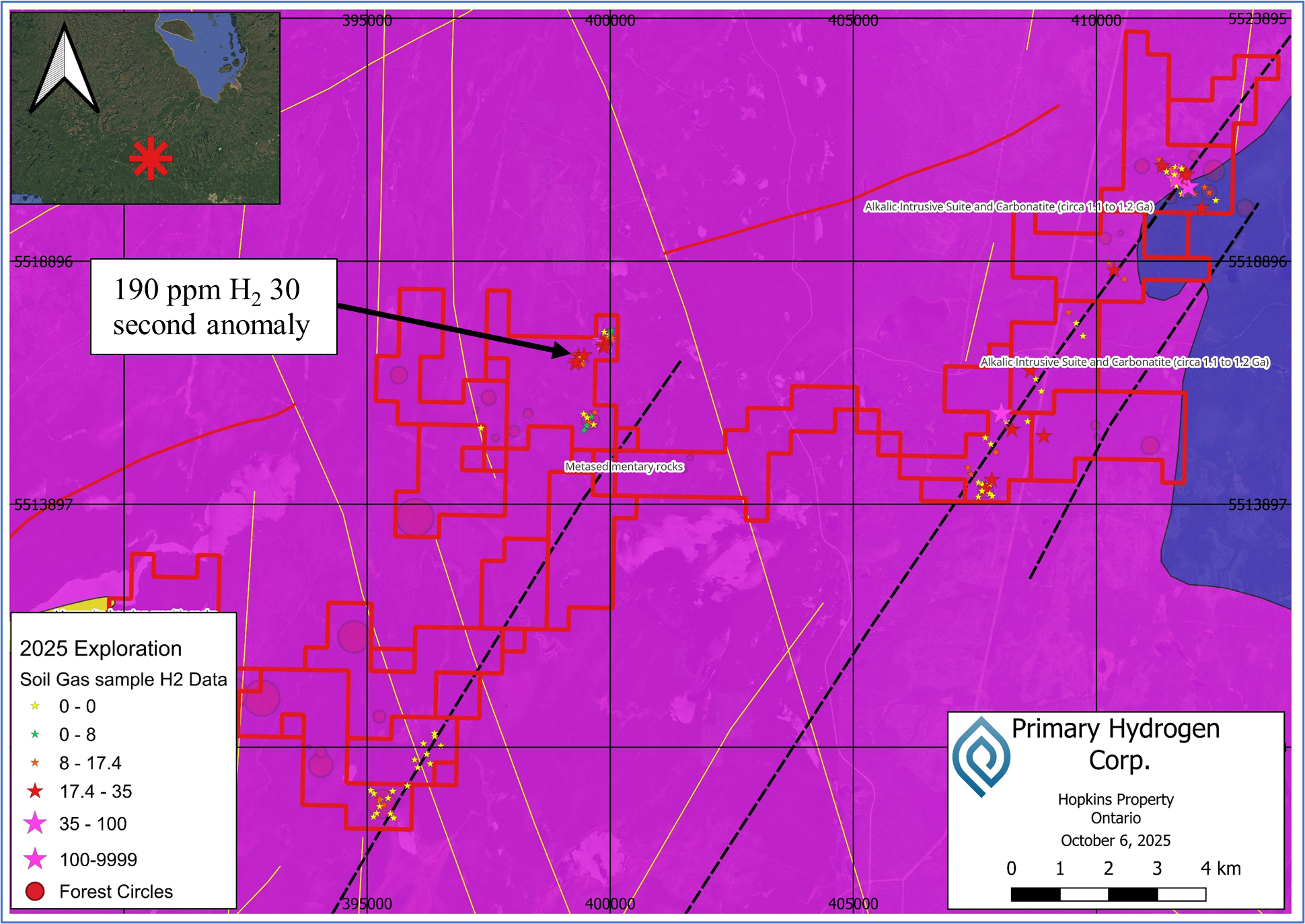
The concentric distribution pattern suggests a localized hydrogen leakage center, potentially indicating subsurface hydrogen accumulation or active generation.
Ambient Air Anomaly
During traverse between stations H062 and H056, field instruments detected a transient ambient air anomaly reaching 190 ppm H₂ over a 30-second interval. This unexpected reading, not associated with any sampling location, warrants further investigation.
Figure 2: Hopkins North Results
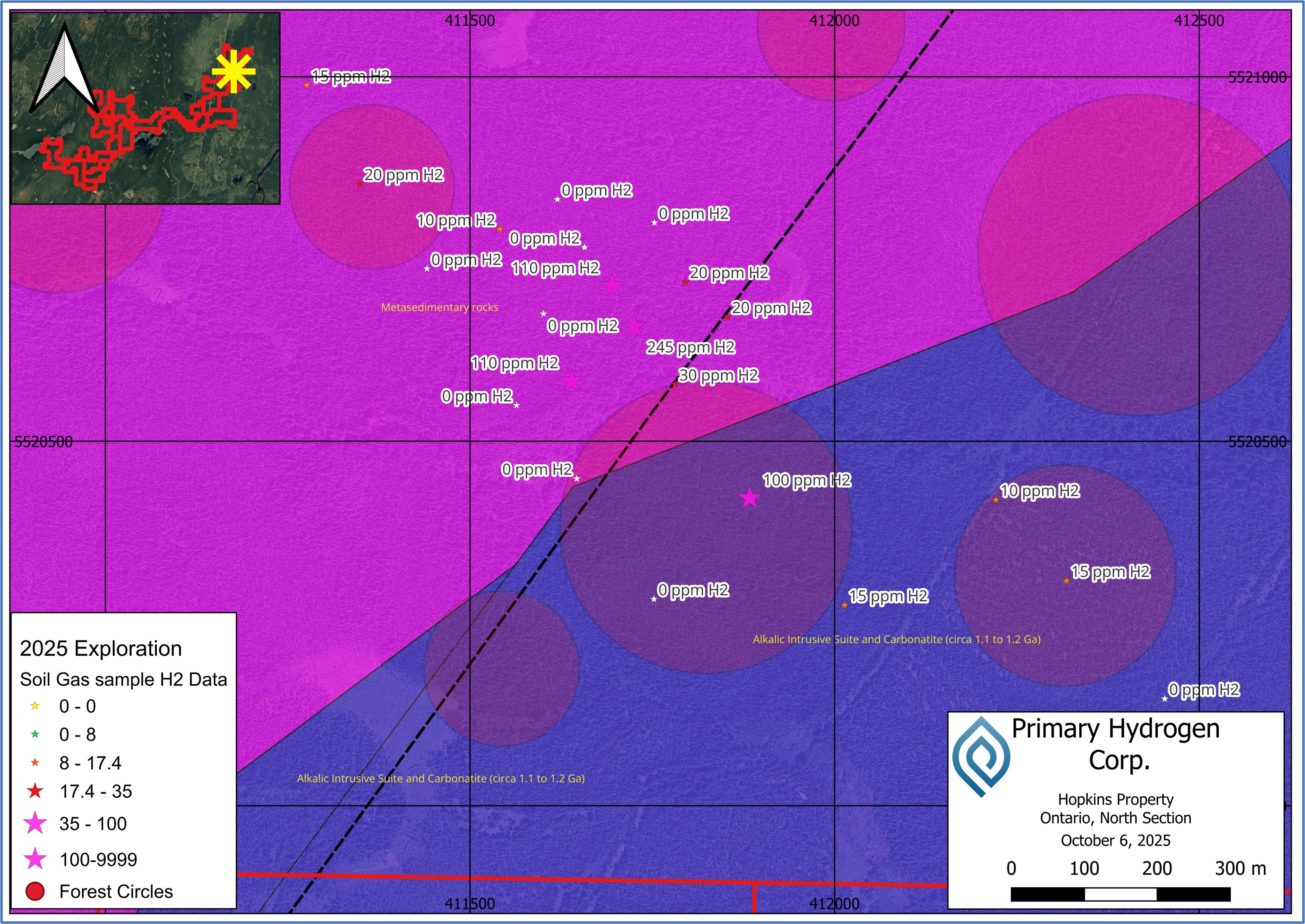
Blakelock Project Results
Geological Setting
The Blakelock claims are underlain by mafic to intermediate metavolcanic with intercalations of iron-rich sedimentary rocks intruded by mafic dykes, with the Norembega Iron Formation in proximity. The property is transected by multiple fault and fracture systems that may facilitate hydrogen migration. The combination of iron-rich lithologies and structural permeability creates favorable conditions for hydrogen generation and accumulation.
Hydrogen Soil Gas Analysis
Sampling focused on the southwestern sector where forest rings are concentrated. Results delineated a north-south trending corridor of elevated hydrogen values extending approximately 800 metres, spatially coincident with a Matachewan mafic dyke.
Key findings include:
Central corridor averaging 52 ppm H₂
Peak value of 77 ppm H₂
Spatial correlation with mapped mafic dyke
Potential indication of dyke-controlled hydrogen migration pathway
Figure 3: Blakelock Results
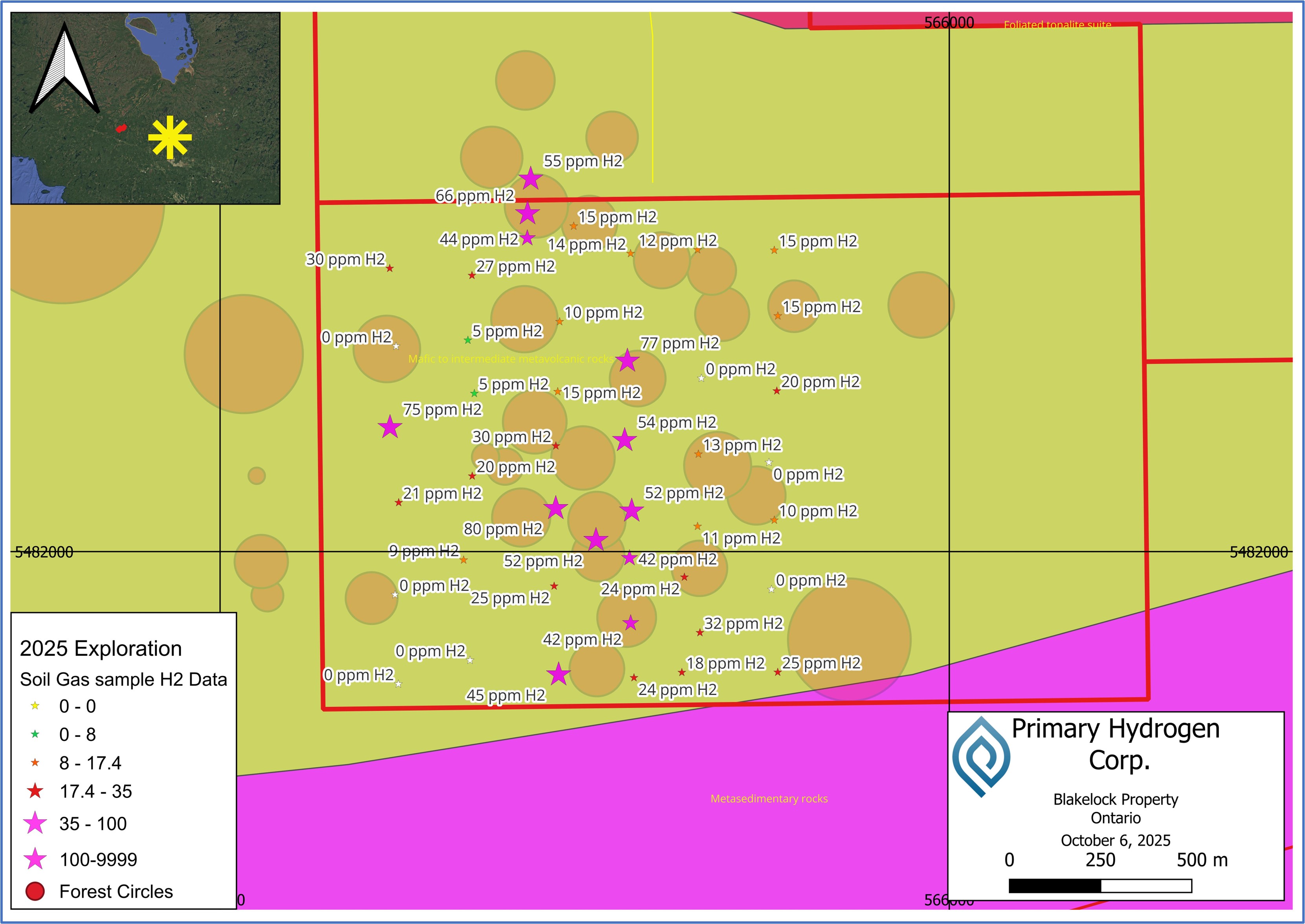
REE Soil Sampling
A complementary soil sampling program targeting rare earth elements (REE) was conducted across both properties. Seventy samples were collected from the humus horizon (20-50 cm depth) due to the absence of B-horizon development in the glacial terrain. Samples were analyzed at ALS Laboratory (Sudbury) using the ME-MS61r method.
Initial results indicate no anomalous REE concentrations above background levels. Six additional samples from the Hopkins carbonatite contact zone remain pending analysis.
Methodology and Quality Assurance
The exploration program employed an integrated approach combining:
Portable gas detection equipment (Dräger XM-8000, ATO Gas Dog H₂)
Conventional soil sampling and geological mapping
Laboratory-verified procedures developed with INRS to minimize artificially generated hydrogen
Real-time field measurements with systematic quality control protocols
All technical activities were conducted under the supervision of Peter Lauder, P.Geo., the Company's Qualified Person as defined under National Instrument 43-101.
Figure 4: Hopkins Ce ppm in Soils
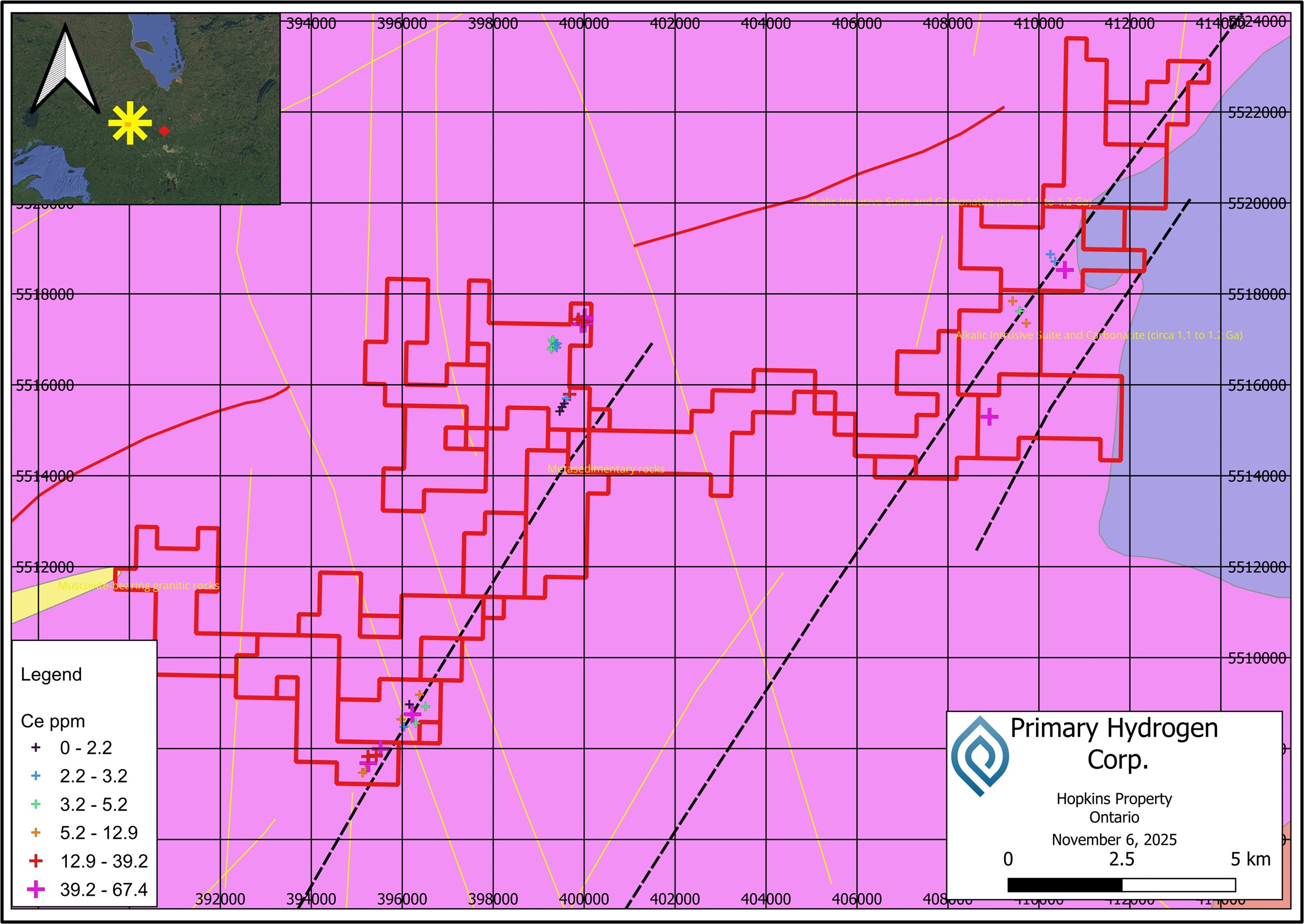
Figure 5: Blakelock Ce ppm in Soils
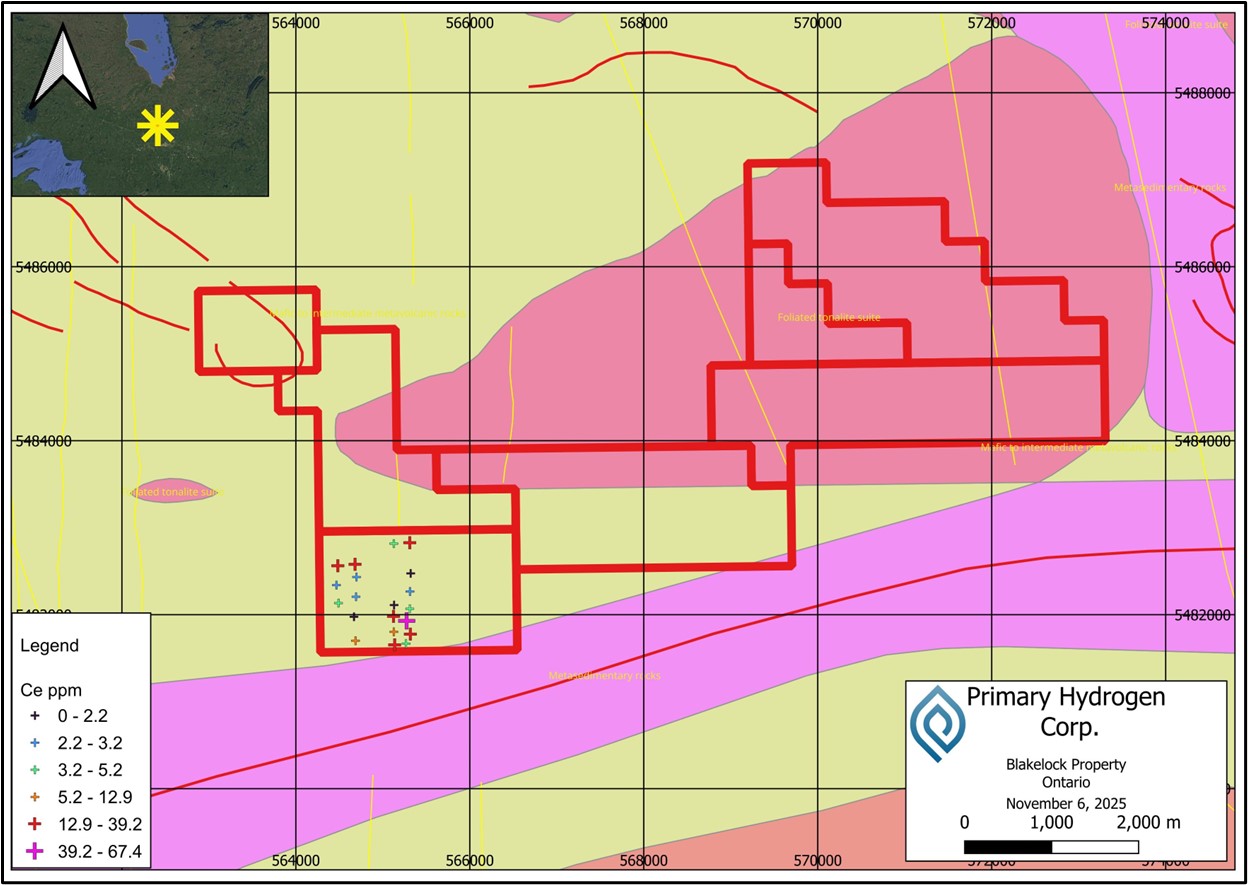
Next Steps
Based on the encouraging results from Phase 2, Primary Hydrogen plans to:
Conduct follow-up surveys to confirm anomalous readings
Expand sampling grids to delineate the full extent of hydrogen anomalies
Complete analysis of pending soil samples
Integrate results with ongoing INRS research on hydrogen sampling techniques
Refine geological models for hydrogen generation and migration
Qualified Person
The technical information in this news release has been reviewed and approved by Peter Lauder, P.Geo., Vice President of Exploration for Primary Hydrogen Corp. Mr. Lauder is the Qualified Person responsible for the scientific and technical information contained herein under National Instrument 43-101 standards.
About INRS
The Institut National de la Recherche Scientifique (INRS) is a leading research and training institution in Canada, dedicated to advancing scientific knowledge and technological innovation. As part of the Université du Québec network, INRS focuses on applied and fundamental research in strategic sectors, including energy, environment, health, and advanced technologies. Through interdisciplinary collaboration and cutting-edge facilities, INRS fosters innovation that addresses societal challenges and supports sustainable development. For more information, visit www.inrs.ca.
About Primary Hydrogen Corp.
Primary Hydrogen is dedicated to the exploration and development of natural hydrogen resources. With over 740 acres in the U.S. and 230 square kilometers across Canada, the Company's portfolio includes the Blakelock, Hopkins, Mary's Harbour, Point Rosie, Crooked Amphibolite, Coquihalla, and Cogburn projects. Primary has an option to acquire a
FOR FURTHER INFORMATION PLEASE CONTACT:
Ben Asuncion
Chief Executive Officer
Primary Hydrogen Corp.
Email: ben@primaryh2.com
CAUTIONARY NOTE REGARDING FORWARD-LOOKING INFORMATION
This news release contains "forward-looking information" and "forward-looking statements" within the meaning of applicable Canadian securities laws. Forward-looking statements in this release include statements regarding: (i) planned follow-up surveys to confirm anomalous hydrogen readings at the Hopkins and Blakelock projects; (ii) expansion of sampling grids to delineate the full extent of identified hydrogen anomalies; (iii) completion of pending laboratory analyses for soil samples; (iv) integration of exploration results with ongoing INRS research on hydrogen sampling methodologies; (v) refinement of geological models for hydrogen generation and migration pathways; and (vi) the potential for subsurface hydrogen accumulation or active generation at identified anomaly locations.
Forward-looking statements can generally be identified by the use of words such as "plans," "expects," "anticipates," "intends," "believes," "estimates," "may," "will," "would," "could," or variations of such words and phrases. These statements are based on assumptions made by the Company regarding, among other things: the accuracy and reliability of field measurements and laboratory analyses; successful execution of follow-up exploration activities; continued availability of funding and resources; favorable weather and environmental conditions for field work; timely receipt of necessary permits and regulatory approvals; the validity of geological interpretations; and the absence of unforeseen operational challenges.
Forward-looking statements involve significant risks and uncertainties that could cause actual outcomes to differ materially from those projected. Such risks include, but are not limited to: the possibility that follow-up surveys may not confirm initial anomalous readings; challenges in distinguishing naturally occurring hydrogen from artificially generated hydrogen; difficulties in accurately delineating subsurface hydrogen accumulation zones; potential delays or increased costs in exploration activities; adverse weather conditions affecting field operations; changes in regulatory requirements; availability of qualified personnel and equipment; and other general economic, market, regulatory, or geological risks detailed in the Company's public disclosure filings available on SEDAR+ at www.sedarplus.ca.
Although the Company believes its expectations and assumptions are reasonable based on current information, there can be no assurance that these forward-looking statements will prove accurate. Readers should not place undue reliance on forward-looking statements or information, as actual outcomes may vary materially from those anticipated. The Company undertakes no obligation to update forward-looking information except as required by applicable securities laws.
Neither the TSX Venture Exchange nor its Regulation Services Provider (as that term is defined in policies of the TSX Venture Exchange) accepts responsibility for the adequacy or accuracy of this release.
SOURCE: Primary Hydrogen Corp.
View the original press release on ACCESS Newswire







